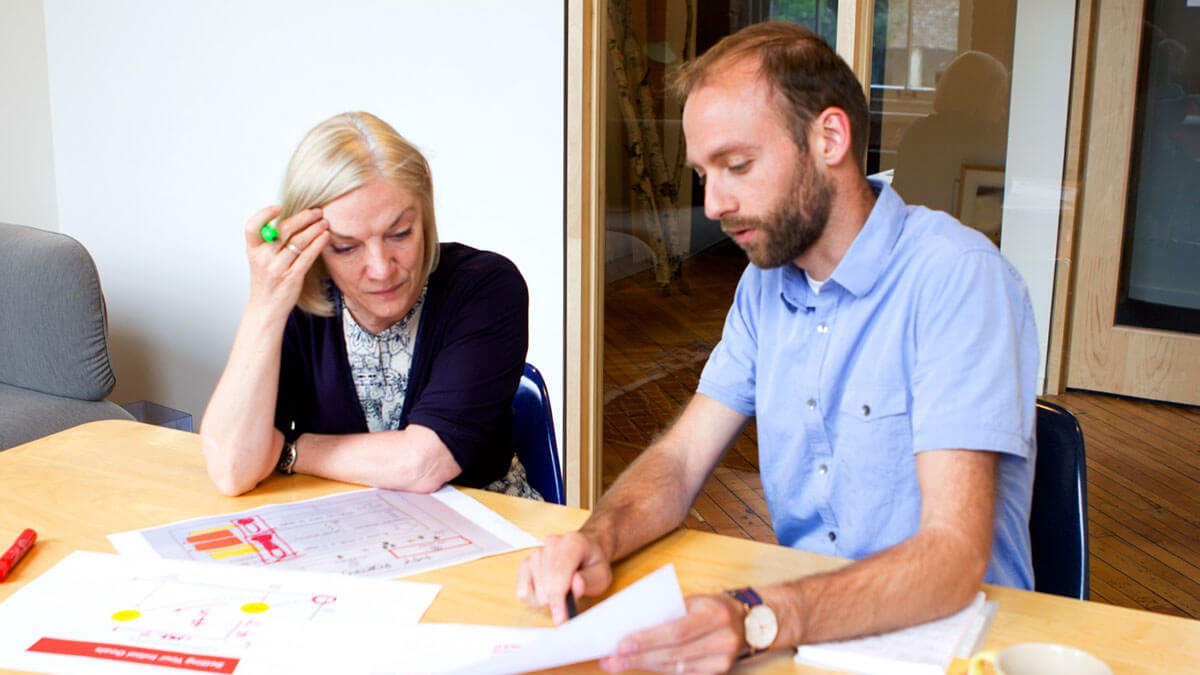
Ideas by Bridgeable
Using design sprints to address complex change
Across sectors, services are becoming increasingly complex, buffeted constantly by the winds of regulatory and consumer change. Using a design sprint approach, we can get up to speed on these changes with low stakes, short-term projects. In this article, we’ll highlight three key factors to keep in mind while applying this approach.
Author
- Bridgeable
Canada’s securities industry is in the midst of significant regulatory changes. For customers looking to invest their money through a financial advisor, management fees (MER) have been a source of significant confusion. The new regulations clearly benefit customers, but will ultimately impact their relationship with their advisor. As advisors try to adapt to increased transparency and new fee disclosure timelines and formats, one of their main concerns is the potential change in the way customers — and prospective customers — perceive the value of their expert advice.
We took on the challenge of prototyping tools that can enhance the spoken, print, and digital interactions between customers and investment advisors, with the goal of meeting regulatory requirements while providing more value for both sides of the relationship. This sounds like a typical design project, except for one detail: we only had two weeks. To achieve our goals in this tight timeframe, we adopted a design sprint approach, which emphasizes quick learning and rapid iteration as a way to effectively respond to shifting external forces.
At the end of the sprint, we had 4 prototypes that both customers and advisors agreed could help them manage expectations and shift their conversations from negotiating fees to discussing overall investment performance in the long term.
Here are the three most important ideas to keep in mind when using a design sprint to respond to complex change:
1 — Get out from behind the desk and talk to real people
By giving ourselves two weeks to understand the challenge, explore different stakeholder perspectives, propose solutions, and test them, we forced ourselves to stay laser-focused throughout the design sprint. In order to accelerate our learning and get to the core of the issue as quickly as possible, we decided to complement our desk research with expert interviews.
We talked to as many people as we could and at each new conversation, we were able to uncover new pieces of our puzzle. The knowledge gained in a one-hour conversation was meatier than that gained in an entire day of desk research, mainly because we had the ability to rapidly test and evolve our hypotheses, sometimes several times in one day.
The knowledge gained in a one-hour conversation was meatier than that gained in an entire day of desk research, mainly because we had the ability to rapidly test and evolve our hypotheses, sometimes several times in one day.
In one case, what we heard helped us quickly shift from thinking about the MER as a narrow communication problem towards thinking about how to contextualize it within larger conversations around investment performance. By learning faster and rapidly iterating our hypotheses, we made sure we were focused on what mattered most in the short time we had.

2 — Focus on the behaviours you want to encourage
The new regulations will change the way things are typically done, eventually breaking expectations that customers have about how to manage their investments. In the best case, this might create room for confusion and surprise. In the most severe, it could lead to new — and sometimes counterproductive — behaviours on both sides of the customer-advisor relationship.
In this context, it was important to focus on the behaviour changes we wanted to achieve. By investing time in understanding why people act the way they do and how they might act in this new regulatory context, we were able to focus on solutions that could help us encourage positive behaviours. In this process, we developed and iterated several unique prototypes, which helped us test the intended behaviour changes, and grounded our solution in features that benefit both sides of the interaction — customers and advisors.
By investing time in understanding why people act the way they do and how they might act in this new regulatory context, we were able to focus on solutions that could help us encourage positive behaviors.
For example, customers often invest their money without clearly expressing their investment goals. Statements like “I want to have $1 million in 2 years” are common, but don’t seem to be very strongly related to tangible outcomes in their day-to-day lives.
So, we created a smart goal setting tool that provides customers with possible goals they can pick from and “tag” their investments to that same goal throughout the entire investment journey, allowing them to check their progress towards, for example, getting all the money to make a down payment on the house they plan to buy in 3 years. This helped advisors tailor their advice while enabling customers to recognize the value of the advisor in the long term.
3 — Embrace the nimbleness and autonomy that a sprint affords
As we moved through the process of uncovering new behaviours, we found that we frequently needed to make course adjustments to our sprint plan. With such a short timeframe, it was crucial that the team maintain a nimble posture and a certain degree of autonomy in making decisions around when and where to pivot.
It was crucial that the team maintain a nimble posture and a certain degree of autonomy in making decisions around when and where to pivot.
For example, we came out of a co-creation session with a solution component that consisted of a physical portfolio that would allow customers to organize the paperwork they receive from their investment advisor (e.g., statements, reports, communication letters). It was the only physical component of the solution among other predominantly digital pieces, and it took a more secondary role in the solution system. While we wanted to keep it, we weren’t sure how to incorporate it in the larger scheme.
After thinking through the solution components and comparing them with our research insights, we realized that the portfolio could be a digital tool to aggregate all other components of our solution, making it the central piece of our proposal. Had we been working with a larger-scale service design project model, it might have taken weeks to build alignment around this kind of pivot. Instead, because of the low-stakes nature of a design sprint and the correspondingly smaller set of stakeholders, we could move quickly toward the right solution.
Adapting can be an exciting adventure
Reflecting on the sprint, beyond delivering robust and validated prototypes, our approach proved extremely effective in moving the sprint team and client through a steep learning curve. In just two weeks, we built significant insights about the industry, the new regulatory requirements, and also about its key stakeholders’ needs and beliefs, building a robust foundation to help our client adapt to external changes.
Looking across sectors, shifting customer expectations, technological innovation and regulatory transformations can dramatically change industry dynamics and redefine client relationships. When change is fast and complex, the design sprint can be the right approach to understand and effectively adapt to it.
Author
- Bridgeable